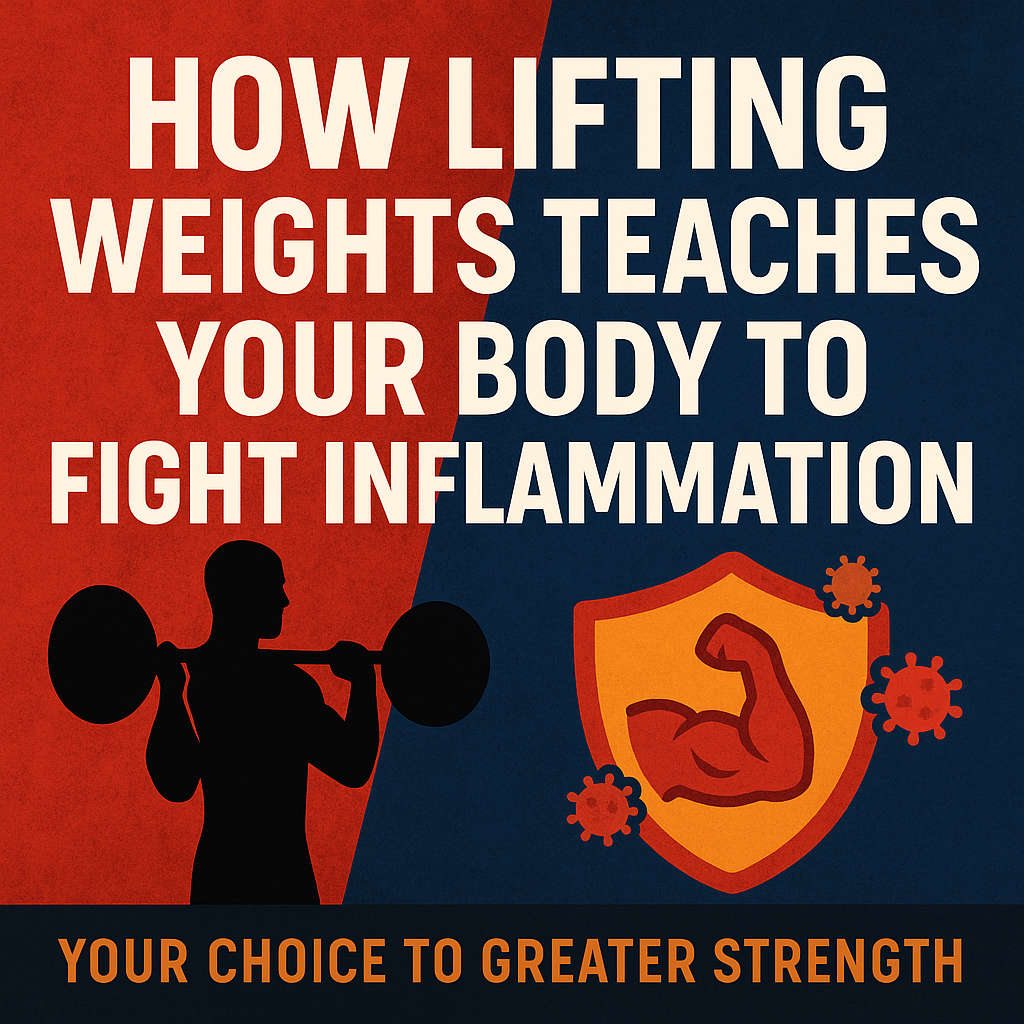
How Lifting Weights Teaches Your Body to Fight Inflammation
Share
Inflammation: The Misunderstood Villain
Say the word inflammation and most people immediately picture swollen joints, chronic pain, or scary headlines linking it to disease. And they’re not wrong — chronic inflammation is bad news. It’s tied to heart disease, diabetes, cancer, arthritis, even accelerated aging.
But here’s the twist: not all inflammation is harmful. In fact, the acute inflammation triggered by lifting weights may be one of the most powerful health tools you have.
Every rep you push through is like a micro-dose vaccine against chronic disease.
The Inoculation Effect of Lifting
When you strength train, you create small amounts of stress and microdamage in your muscle fibers. This isn’t a flaw, it’s the point. That stress sets off a short burst of localized inflammation:
-
Immune cells rush in to clear debris.
-
Cytokines (messenger molecules) spike and then flip anti-inflammatory.
-
Repair and remodeling kick in, leaving you stronger than before.
Think of each training session as controlled chaos. Your body learns how to respond, resolve, and recover, so the next time, it’s faster and more efficient. Just like your immune system remembers a vaccine, your body “remembers” exercise.
This repeated cycle becomes your defense against the slow burn of chronic inflammation that wrecks health over time.
Why This Matters: The Difference Between Acute and Chronic
-
Acute inflammation = sharp, short-lived, targeted. It’s your body’s emergency repair crew.
-
Chronic inflammation = low-grade, lingering, systemic. It’s like a faulty smoke alarm that never shuts off, eventually damaging your own house.
Here’s the key: resistance training helps your body practice acute inflammation so it can prevent chronic inflammation.
That’s why research shows people who train consistently have lower baseline markers of inflammation like CRP, IL-6, and TNF-α compared to sedentary individuals【pmc.ncbi.nlm.nih.gov/PMC3629815】.
The Science: How Muscles Talk to Your Immune System
Your muscles aren’t just meat slabs for flexing they’re actually an endocrine organ. When you train, your muscles release signaling molecules called myokines.
One of the most famous is IL-6. During exercise, IL-6 skyrockets (sometimes 100x baseline). But here’s the kicker: instead of being inflammatory, this spike actually turns anti-inflammatory. IL-6 suppresses TNF-α (a pro-inflammatory signal) and triggers IL-10 and IL-1ra — molecules that shut down runaway inflammation【pmc.ncbi.nlm.nih.gov/PMC2615833】.
In other words: your workout flips the script. A molecule that in chronic conditions is harmful becomes a beneficial signal in the context of training.
That’s why studies keep showing that people who lift or exercise consistently have lower chronic inflammation and better immune regulation【frontiersin.org/articles/10.3389/fpsyg.2023.1253329】.
The Payoff: Why You Should Train for Resilience, Not Just Looks
Yes, lifting weights will build muscle, strength, and confidence. But the deeper win is resilience.
By giving your body regular, controlled stress, you:
-
Train your immune system to regulate itself better.
-
Reduce the background “smoldering” inflammation linked to disease.
-
Boost your recovery capacity from other stressors (poor sleep, illness, even injuries).
-
Protect your long-term health while looking better today.
This is why lifting weights isn’t vanity. It’s medicine. It’s a shield against the very thing that accelerates aging and disease.
Practical Takeaways
-
Be consistent — benefits come from repeated “doses” of training, not one heroic session.
-
Mix intensity and recovery — train hard, then let your body resolve inflammation fully.
-
Don’t blunt the process — avoid popping NSAIDs after every workout; they can interfere with the adaptation process.
-
Fuel recovery — prioritize protein, omega-3s, and sleep to optimize the resolution phase.
Conclusion
Stop thinking of inflammation as something to fear. When you lift weights, the short-lived inflammation you spark is the very thing that helps your body learn, adapt, and defend itself.
Every set is a signal. Every rep is a rehearsal. Over time, you’re not just building muscle, you’re building an immune system that’s sharper, stronger, and harder to break down.
So if you’re serious about health, longevity, and looking like you actually lift — pick up the weights. The barbell is your inoculation.
References:
-
Petersen AM, Pedersen BK. The anti-inflammatory effect of exercise. J Appl Physiol. 2005;98(4):1154-1162. 【PMCID: PMC2615833】
-
Gleeson M et al. The anti-inflammatory effects of exercise: mechanisms and implications. Nat Rev Immunol. 2011;11(9):607-615. 【PMCID: PMC3629815】
-
Fedewa MV et al. The effect of exercise training on C-reactive protein: a meta-analysis. Br J Sports Med. 2017;51(8):639-646.
-
Frontiers in Psychology. Physical activity reduces inflammation: a meta-analysis of RCTs (2023). 【frontiersin.org/articles/10.3389/fpsyg.2023.1253329】
